Chapter 6 Chapter Three: Fighting for a Thousand Years
The Roman Empire suffered three major invasions.The first invaders were Germanic barbarians, then Muslims (referring to Islam), and then Nordics, or Vikings.After years of wars, European society finally stabilized and began to expand outwards—the Crusades conquered the Holy Land, expelled Muslims from Spain, and then plundered treasures and cultural relics from all over the world by sea.
When we talk about the fall of the Roman Empire, we always give it a date: AD 476.However, only the Western Roman Empire perished that year; the Greek-speaking Eastern Roman Empire, with Constantinople as its capital, continued to exist for another thousand years.Constantinople was originally a city in Greece. Its real name was Byzantium (pronounced in Latin), so the Eastern Roman Empire was also called the Byzantine Empire.About its demise, we will discuss later.
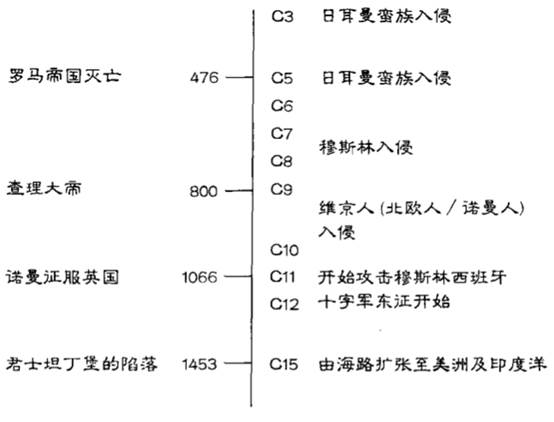 As for the Western Roman Empire, it is actually misleading to say that it "falls" and to set a date.This is not a picture of the barbarians gathering at the border, pushing southward step by step, the Romans retreating steadily, and finally fighting with their backs in the city of Rome.Not at all.It was a very unusual invasion, and you might as well follow the flow of the different Germanic barbarians on the map.
The northern frontier of the Roman Empire was never a completely closed barrier.At a number of tacit frontier points, Rome and foreigners had been in contact, exchanging goods under the supervision of Roman soldiers.Sometimes it was Rome itself that crossed the general borders; in the 1st century AD, the Roman army crossed the Rhine and marched across the Rhine to invade what is now Germany.The invasion was short-lived, and the barbarians destroyed these armies and learned more about Rome as a result.
As for the Western Roman Empire, it is actually misleading to say that it "falls" and to set a date.This is not a picture of the barbarians gathering at the border, pushing southward step by step, the Romans retreating steadily, and finally fighting with their backs in the city of Rome.Not at all.It was a very unusual invasion, and you might as well follow the flow of the different Germanic barbarians on the map.
The northern frontier of the Roman Empire was never a completely closed barrier.At a number of tacit frontier points, Rome and foreigners had been in contact, exchanging goods under the supervision of Roman soldiers.Sometimes it was Rome itself that crossed the general borders; in the 1st century AD, the Roman army crossed the Rhine and marched across the Rhine to invade what is now Germany.The invasion was short-lived, and the barbarians destroyed these armies and learned more about Rome as a result.
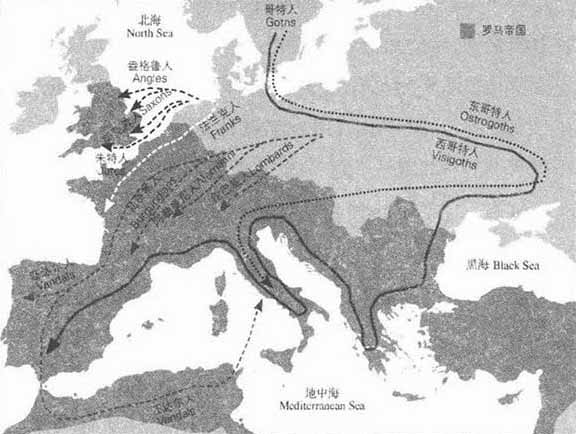
Figure 3-1 Invading Germanic barbarians and the Roman Empire.
The Germanic barbarians also invaded many times in the 3rd century AD, and almost destroyed the Roman Empire.At that time, the Roman regime was in turmoil, and many emperors stepped down as soon as they came to power. They were powerless to resist foreign aggression.Constantine the Great, the Roman emperor who officially announced his support for Christianity in 313 AD, tried to rectify after the war, hoping to restore the glory of the empire.
The Roman army enlisted the Germanic peoples who had settled in the territory, so in the fifth century invasion, Germanic people fought on both sides.The Germans in the Roman army accounted for half or more, and some even ranked among the generals.It seemed a clear sign of weakness that the Romans had to get the Germans to fight in their stead.In the early twentieth century, when racial consciousness was on the rise, some people thought that the reason for the fall of the Roman Empire was self-evident: the Romans made a big mistake and put their fate in the hands of a people who were not as good as themselves.Of course, this is a shallow view, which has now been discarded.
However, an empire has to rely on newcomers to resist foreign aggression, which shows its weakness.
The Germanic peoples had no desire to take over the Roman Empire.They are just aggressors, they don't want to be conquerors.They just want to get a piece of the pie, settle down on this land, and live a comfortable life, so they are willing to recognize the rule of the Roman emperor.
Of course, those emperors did not like the plundering of foreigners in their territories, so they sent troops to suppress or expel these invaders, but it can only be said that there were occasional gains. In the end, there was not much land left in the Roman Empire to govern.However, the Germans believed that there should still be an emperor here.For a long time, these invaders had a Roman as their emperor.
The farce was finally interrupted by a Germanic general.He decided not to support a puppet regime, but to openly claim the king by himself.This is what happened in AD 476, not some grand final battle.This Germanic leader was called Odoacer. He took over the empire, but he did not proclaim himself Emperor, but King of Italy.He wrapped up the royal symbols of the Western Roman Empire—the crown and royal robes—and sent them to Constantinople, where another emperor reigned, acknowledging that emperor’s right to rule.The Germans basked in the glory of their unintentional conquest.
As a result, the West is no longer a unified empire, but small kingdoms established by different Germanic nations stand side by side.These small countries rose and fell rapidly, unable to maintain the old Roman regime at all, and soon even stopped tax collection.Basically, "government" was far beyond the capabilities of these conquerors; they had no experience in governing a stable country, and they asked everywhere for help, and finally got help from the Roman landowner class and the bishops of the districts.The new and the old ruling classes are fused, but what about the next situation?
We don't know the details because there are very few written records from that era.The Germans were illiterate, and it was a time of war and chaos, so there are very few textual documents that have survived to this day.One thing is clear, though: This is not a massive invasion.The Germanic barbarians did not drive out the original residents, nor did they attack the territory with strong soldiers.These Germans, with their wives and children, intended to settle here; in some places they formed dense communities, in others scattered and sparsely populated.An archaeologist is necessary to determine who settled where; the Germanic burials were different from the Romans, so a location with many dead buried in a Germanic way indicates a densely populated Germanic settlement .Linguists are also useful; if a village has a Germanic name, it stands to reason that it is a densely populated settlement of Germanic immigrants.However, this evidence may not be strong enough, because the change of the place name may also be the result of an order from a German general, but if the name of the field is changed, the evidence is stronger, which means that there are indeed Germans farming on this land.
For a time, Germanic law and Roman decree went hand in hand.The laws under which criminals were tried depended on their racial origin.Roman law upholds clear and distinct principles of fairness and justice, allowing judges to make decisions based on the merits of the case.The early judges were legislators, and their judgments were compiled into legal codes, the greatest of which was compiled by the order of Emperor Justinian of the Eastern Roman Empire in the 6th century. Dacheng, the role of the judge is just to sit on the sidelines.If someone violates another person, the injured person and his relatives will go to the other party and his relatives to seek compensation. Even if it is a homicide case, the matter can be settled by paying the relatives of the deceased.The amount depends on the status of the victim, and the compensation for the noble class is three times higher than that of ordinary people.
The Romans judged guilt or innocence based on evidence and witnesses, while the Germans used torture such as burning and flooding or fighting.For example, if the suspect's arm is soaked in boiling water, if the arm does not heal after three days, the person is guilty;If the two parties have a dispute over land, they can go to war, and the winning party can justifiably claim ownership.
The two legal systems gradually merged into one.In Italy and southern France, Roman law prevailed, while Germanic lynching prevailed slightly in northern France.And no matter where, the priest was present during the torture trial to ensure that God made the right sentence.In this regard, the Holy See has always followed the Germanic route. It was not until the 12th century, when the church was influenced by the unearthed "Justinian Code" that warned clergy not to participate in torture, that the situation changed.
The Germans converted to Christianity not long after the invasion, denying their original gods or the Arianism they had converted to before the invasion.Arianism is a school of Christianity that is regarded as a heresy. The main doctrine is that Jesus, as the Son of God, is bound to be inferior to the Father in all aspects and cannot be compared with God.This sect was popular in the Eastern Roman Empire for a period of time, and then was brought to Germany by missionaries, and many Germans became believers of this sect.
Therefore, "the fall of Rome" is misleading in many ways, but the most misleading is the religious aspect-the Roman Empire's state church and the Holy See actually survived, and were even embraced by the invaders.This is the starting point, and the foundation of European civilization was laid.We have already stated this before: the Germans supported the Roman Christian Church, and the Roman Church preserved the learning of ancient Greece and Rome.
In the West, only one state established by the Germanic peoples lasted for a long time, and that was the Frankish Kingdom.You can see from the map that its territory is constantly expanding. In addition to today's France, parts of Germany, Spain and Italy are also included in its borders. The name "France" (France) is a derivative of Franks, so France also originated from the Germanic nation.The Frankish kingdom reached its apogee during the reign of Charles the Great (Charlemagne), and after his death the kingdom was divided.Modern France is not a direct descendant of the Frankish kingdom. What we call France today is actually a gradual integration of many kings after that kingdom.
The pattern of Germanic aggression against England was quite different.The territory of the Roman Empire covered more than half of modern-day Britain, excluding Scotland.The Romans came to England late (1st century AD) and left quickly; in 410 AD the emperor recalled the garrison here in order to resist the Germanic invasion.After the Romans left, the original English Celts remained intact and were not exterminated by the Romans who lived here for three hundred years.The Celtic language they spoke survived.Afterwards, the Germanic nations of Angles, Saxons and Jutes invaded England across the Channel in the 5th and 6th centuries.This time it looked more like a total conquest; the British were overthrown, save for Scotland, Wales, and Cornwall in southwestern England.
In this way, the whole of England became a Germanic society; in addition to many independent kingdoms, it also became a pagan state, because the Angles, Saxons and Jutes did not believe in any school of Christianity.Later, missionaries from Ireland and Rome came to England and called these new immigrants into Christianity.With regard to the conversion of England, Ireland played an important role, leaving a touching chapter in the survival of Christianity.
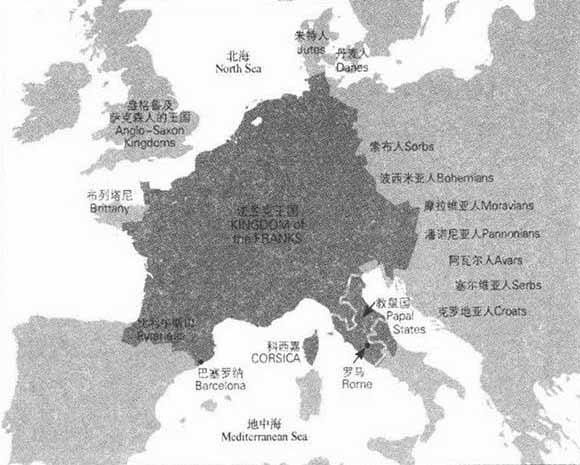
Figure 3-2 The Kingdom of France and Croatia continued to expand. In addition to today's France, parts of Germany, Spain and Italy were also within its territory.
Christianity originated in the Near East of the Roman Empire, spread from there to the entire empire, and then crossed the border to Ireland.It became a unique kind of Christianity here, because the society was not tinged with Rome.When the Western Roman Empire was invaded, Ireland not only survived, but even brought England back to Christianity and sent missionaries to Europe.The British looked down on the Irish and called them "hillies", but the Irish knew that they saved the life of Christendom.
The third major invasion came from the Muslims, in the 7th and 8th centuries, only two hundred years after the Germanic barbarian invasion.The founder of Islam, Muhammad, was an Arab businessman who founded the religion after receiving the revelation from God.His religion, which was developed by divine assistance, is closely related to Judaism and Christianity; Muslims also recognize that Jesus and the prophets before Jesus were indeed prophets, but firmly believe that Muhammad is the last prophet in the world and can guide everyone to the only true God. pull the arms.Islam is much simpler than Christianity.They don't have the whimsy of the Greeks, who believed that the God of Christianity is a trinity—the Father, the Son, and the Holy Spirit. The three have different divisions but are equal in status, and they are different but form the same entity.In Islam, the only God is Allah.Muslims are quite tolerant towards Christians and Jews, but Christians always think that Muslims are deceitful and destroyers of true faith.
Muhammad conquered pagan tribes by force, forced them to submit, and won a large area of Arabia for his new faith.His influence during his lifetime was far greater than that of Jesus: he founded a religion that firmly took root in a vast land. In contrast to Jesus, until the time of his death, there was no shadow of Christianity.After Muhammad's death, his believers continued to fight north and south, with great momentum.Without stopping, they conquered other tribes and established states, first in the Persian Empire, and later in the Middle East and North Africa of the Eastern Roman Empire.They continued westward along North Africa, not only felling the kingdom built by the Germanic barbarian invaders, but also crossing the sea into Spain.
Spain was originally a province of the Roman Empire, was later invaded by the Visigoths (Visigoths), became a Christian country, and now it has become an Islamic country.
The Muslim conquest ends here.An Islamic army that penetrated into France was defeated at Tours. At that time, the commander of Frank was Charles Martel, whose grandson was Charlemagne.The Franks saved Europe by preserving Christianity.
Muslims, though ruthless conquerors in Christian eyes, were gentle rulers.They allow Christians to continue worshiping their gods, but pay taxes for non-Muslims—Muslims don’t.This is an inducement to convert people to Islam.Christians under the rule of the Eastern Roman Empire actually welcomed Muslims into their rule, because they had long complained about the Christian norms that Constantinople imposed on them.Under Islam, they could worship as they please, but Christianity gradually faded out in these lands, and finally disappeared.As more and more people convert to Islam, tax rules will of course have to be changed, and before long everyone is equal and will have to pay a land tax.
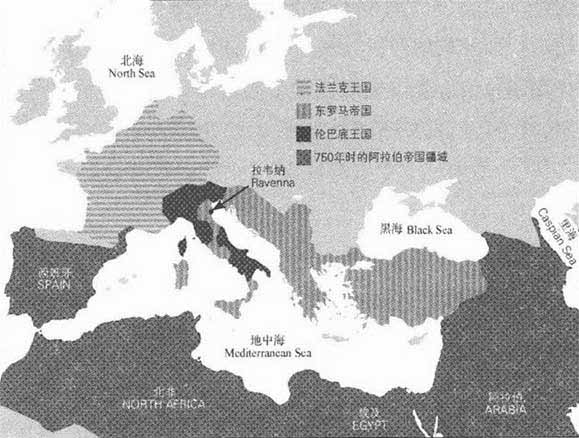
Figure 3-3 Muslim occupation.Among the Eastern Roman Empire, only the Balkan Peninsula and the current Turkey region did not fall.The Eastern Roman Empire had retaken some Italian territories.Italy, once part of the Western Roman Empire, had been invaded by Germanic barbarians, and the emperor of Constantinople felt it was his Christian duty to reclaim these lands.His small gains came at a high price; his efforts to recover lost lands resulted in far more social chaos and bloodshed than the Germanic aggression.Ravenna in northern Italy was one of his recovered territories, which explains why the city has preserved beautiful Byzantine mosaics.
Under the rule of Islam, Spain became the most civilized region in medieval Europe.The illiterate Arab barbarians fought north and south, learning from the peoples they conquered along the way, including the highly civilized Persians and the Greeks of the Byzantine Empire.
The Arabs brought Greek learning to Spain, not only putting it into words, but also interpreting it in detail, and allowing scholars in northern Europe to copy it.Jews have a high status in Muslim Spain and often act as translators; one person reads in Arabic a document that has previously been translated from Greek to Arabic, and then translates it aloud in Spanish, while the other listens to the Spanish language. , written in Latin on one side.In this way, Greek theories were brought back to the universities of Christian Europe for study in the new Latin version after three translations (Europe began to build universities in the 12th century).In this way, Western Europe acquired Aristotle's writings on logic, as well as works on medicine, astronomy, and mathematics-disciplines in which the Greeks were the masters.
Now, we want to summarize the results of these three campaigns.First, in Western Europe, the Germanic nation, ancient Rome and Christianity were thus melted into one furnace.Second, the whole of England was occupied by Germanic barbarians, and then returned to the Christian faith.Third, in the Islamic world (Middle East, North Africa and Spain), Christianity disappeared completely, but Greek learning was preserved and spread to Europe.
The Vikings, also known as the Normans and the Nordics, were the last group of invaders who ran rampant throughout Europe in the 9th and 10th centuries, that is, the two centuries after the Islamic occupation.The Vikings' homeland is in the north - Sweden, Norway, Denmark, and they attacked by sea.Their gigantic longships are truly an astonishing sight. These boats have such a shallow draft that they float in just a meter of water, allowing them to sail long distances up rivers.When the river became shallow, they put down the small boats they carried on the longboats and continued sailing; when they encountered obstacles, they carried the boats around the barriers and continued to row.In this way they were able to penetrate far inland; they were found in Russia from the Baltic to the Black Sea.
The open-air longboats can only go to sea in summer.In the beginning, the Vikings would go out in the summer and return home for the winter.Their purpose was plunder: to take valuables, something that could be carried back.However, as well as hunting for valuables, they also survived by plundering, taking food, horses, women, and not just what they needed.They are determined terrorists; they not only sneak attack and loot, but also burn, kill and loot, and destroy everything that cannot be taken away.Their purpose is to create a general panic, they are ruthless, and the people will run for their lives in fear when they hear the news.In Norse sagas there is a Viking warrior known as the Guardian of the Children because he refused to pierce and disembowel children by piercing them with the point of a spear.
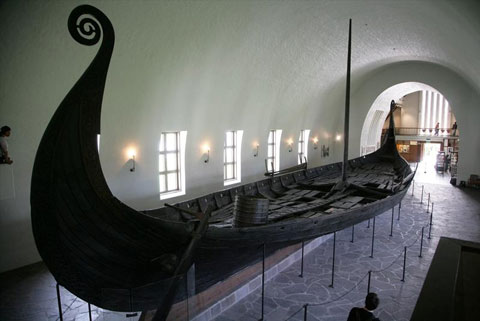
Figure 3-4 The longship of the Vikings.The draft is very shallow, so it can go up the river and go deep into the inland to attack.
The former Germanic barbarians came in by land, and the safest place to avoid being plundered seemed to be the inland river or near the coast, so monasteries were built in these places; Became their bag.
The monastery is a big fat sheep in the eyes of robbers, because there are a large amount of objects made of gold and silver in it, and there is a lot of food-they are self-made and self-sold, and the food storage must be enough to supply one or two hundred monks.There is a monastery at the mouth of the River Loire in France, built on a small island near the coast; every summer, these monks have to move inland along the river, but the Vikings always catch up with longboats.The monks of this monastery migrated along the Loire River four or five times with their personal golden cross, the large cross stained with the blood of Jesus, and a leg bone of Christ before finally settling down in present-day Switzerland.
The reason why the Vikings were able to continue to attack without encountering resistance was because the government was weak and weak.They do not have a normal tax collection system, and even if they have the ability to integrate into an army, the invaders do not come from land.None of the small kingdoms of Western Europe had a navy, and Charlemagne never had one under his command, and besides his empire has now vanished into thin air.The Roman Empire once used the “sea”—itself an integrated territory centered on the Mediterranean Sea—but now most of this sea area has fallen into the hands of Muslims.There was very little maritime trade among European countries, and navigation technology was completely wiped out. Because of the inland development, the whole of Europe easily became the prey of foreign enemies with strong mobility.
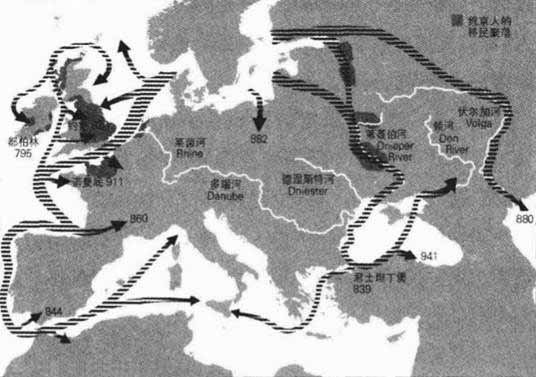
Figure 3-5 The Vikings, or Nordics, roamed across Europe in the 9th and 10th centuries.
After a while, the Vikings brought their wives and children and established a permanent home here.Their settlements can be seen on the map, scattered throughout Russia, northern France, England and Ireland.Dublin was originally a Nordic city. Britain suffered two invasions. The first was the Anglo, Saxon and Jutes, and then the Vikings who came in from the east of the island.Both groups spoke the Germanic language from which English evolved.There is an immigrant area in northern France called Normandy (Normandy), which is named after the Vikings (also known as the Normans) who settled here.The king of France let them live here, on condition that the plundering activities cease.
A hundred years after the Normans had settled in northern France, William, Duke of Normandy, led a small entourage to conquer England in 1066. This was only a change of hands for the upper classes; Duke William and his entourage began to regard themselves as the new rulers of England.The Normans spoke their own version of French, which later merged into languages that eventually became English.British society is full of invaders, but there have been no foreign invasions since 1066.
The invasion of Europe from the outside world ceased after the 10th century.The Vikings were persuaded to establish a home here, and missionaries advanced to Norway and Sweden, converting them into Christian countries.Trade revived and towns began to expand.Now, European society has not only become stable, it is even strong enough to go on expeditions to attack others.
The first task of the Christian world is to drive the Muslims back to their homeland.These campaigns mobilized the whole of Europe, first to recover Spain and then with the goal of retaking the Holy Land of Jerusalem.The campaign to recover Spain began in the 11th century and took more than four hundred years to complete. Christians attacked from north to south in stages, first capturing a large area of land and rebuilding a Christian society before continuing to march south. In 1492, the same year that Columbus set sail westward with financial support from the Spanish royal family, the last group of Muslims were finally driven out of southern Spain.
The Crusaders began their expedition to the Holy Land in 1095 and continued to attack for nearly two centuries.Think about it, when these Christians know that the place where Jesus preached and was buried is now in the hands of apostate pagans, and these pagans are still enemies of Christianity everywhere, they will be excited, thinking that God must want them to wash away Such a shame.For these jihads, the pope not only encouraged, but also rewarded.However, only the first of these campaigns was successful.The Christians briefly recaptured Jerusalem, and some crusaders stayed on permanently, but the Muslims drove them out again, and subsequent conquests failed.
The Crusades were the result of multinational cooperation. In contrast, the expansion across the sea to America and Asia from the 15th century was a competition among several emerging nation-states—first Spain and Portugal, followed by Britain, France and Netherlands.The primary goal of these countries was to acquire the spices and wealth of Asia.They split into two routes: bypassing southern Africa by sea, or heading west across the Atlantic.Columbus was going to China, but accidentally discovered the American continent. The return of this discovery far outweighed the disappointment, because the Spanish dynasty that funded him has since then mastered the gold and silver mines in Central and South America.The Portuguese were the first to arrive in Asia, but they were swept aside by Britain and France, who were vying for the domination of India, and the Netherlands, who were vying for the East Indies (now Indonesia).
Luxury goods from Asia had been introduced to Europe very early, but they all came through Constantinople, the capital of the Byzantine Empire.The Europeans switched to the sea route, partly because the land route to the east had fallen into the hands of Muslims.
This is more like a real "death". In the 5th century, the attacks of the Germanic barbarians were concentrated in the Western Roman Empire, so the Eastern Roman Empire survived and may be more prosperous economically and politically, but its country began to lose step by step. From the 7th to the 8th centuries, a large piece of territory was taken away by Arab Islamic invaders. In the 9th century, the Turks came one after another via the Asian prairie.They took what is now called Turkey from the Eastern Roman Empire, converted to Islam one after another during their southward and westward expeditions, and the entire Middle East fell into their hands.They also crossed mountains and seas to Europe, and the territories around Constantinople fell one after another, besieged on all sides. In 1453, the Turks finally captured the capital of the Eastern Roman Empire.The last Eastern Roman emperor died in battle.In this way, the land was reduced to a square inch, and the Roman Empire, which had more Greeks than Romans in its population, finally came to an end.
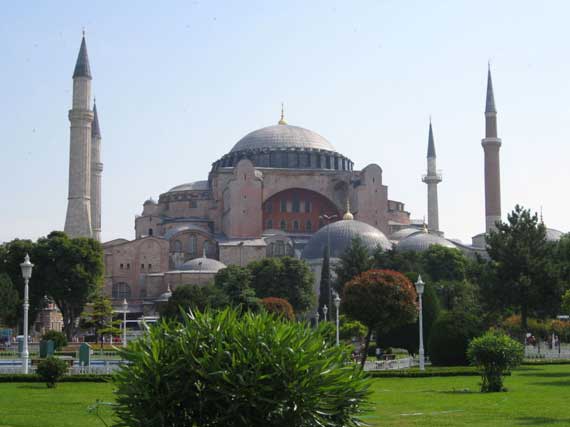
Figure 3-6 The Hagia Sophia, built by Justinian in the 6th century, was once turned into an Islamic mosque and is now a religious museum.
The Hagia Sophia (Hagia Sophia, meaning "the wisdom of God") built by Justinian in the 6th century was converted into an Islamic mosque.The Turks themselves also founded an empire called the Ottoman Empire.The empire came to a halt after the First World War, and today's Turkey has become a secular state, although the vast majority of the population still believes in Islam.Hagia Sophia, originally built for Christians and later turned into an Islamic mosque, is now a religious museum.
After the fall of Constantinople, the Christian scholars who had preserved and studied ancient Greek scholarship personally fled to Italy with these precious manuscripts.They are warmly welcomed here, as Renaissance scholars scour classical texts.As early as 1453, Italian scholars had communicated with Constantinople scholars in order to get acquainted with Greek scholarship and literature.Previously in Western Europe, Latin scholarship and literature had been preserved without interruption.Some Greek scholarship survived in Latin originals, and while Roman literature as a whole was deeply influenced by the Greeks, these original Greek works came after long intervals and great detours--Spain in the Middle Ages and Constantine in the fifteenth century. Fort - just arrived in Western Europe.


Figure 3-1 Invading Germanic barbarians and the Roman Empire.

Figure 3-2 The Kingdom of France and Croatia continued to expand. In addition to today's France, parts of Germany, Spain and Italy were also within its territory.

Figure 3-3 Muslim occupation.Among the Eastern Roman Empire, only the Balkan Peninsula and the current Turkey region did not fall.The Eastern Roman Empire had retaken some Italian territories.Italy, once part of the Western Roman Empire, had been invaded by Germanic barbarians, and the emperor of Constantinople felt it was his Christian duty to reclaim these lands.His small gains came at a high price; his efforts to recover lost lands resulted in far more social chaos and bloodshed than the Germanic aggression.Ravenna in northern Italy was one of his recovered territories, which explains why the city has preserved beautiful Byzantine mosaics.

Figure 3-4 The longship of the Vikings.The draft is very shallow, so it can go up the river and go deep into the inland to attack.

Figure 3-5 The Vikings, or Nordics, roamed across Europe in the 9th and 10th centuries.

Figure 3-6 The Hagia Sophia, built by Justinian in the 6th century, was once turned into an Islamic mosque and is now a religious museum.
